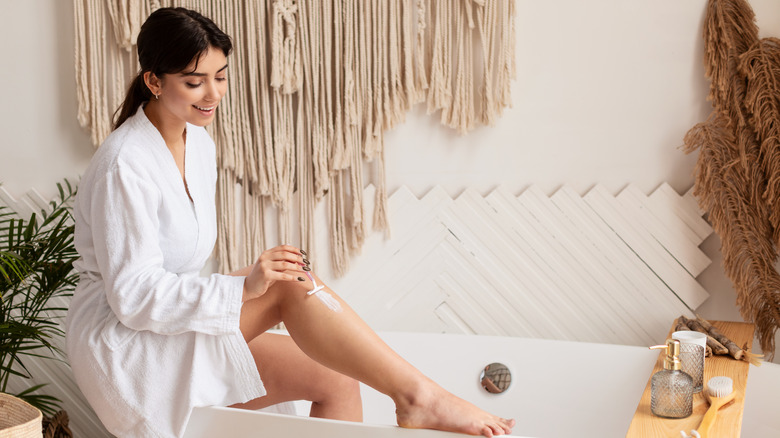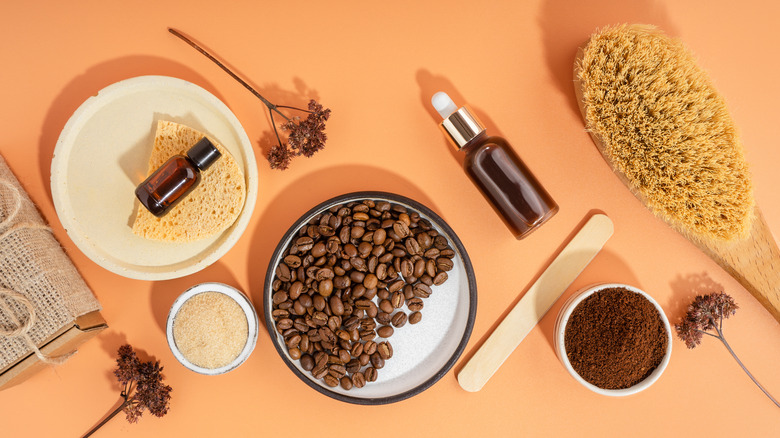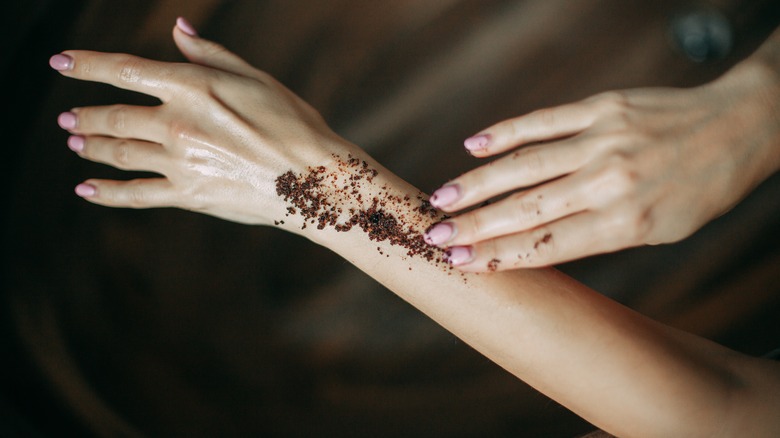Is It Better To Exfoliate Before Or After You Shave?
Shaving with a razor blade can be a quick and convenient way to get rid of excess body hair. Plus, it's relatively painless. The downside is that you might end up with razor burn, bumps, or ingrown hair. As Everyday Health notes, the contact between the razor blade, your skin, and body hair is what causes red bumps and irritation, especially for those with sensitive skin. Shaving may also cause pimples or dermatitis and worsen acne, per Hims.
One way to mitigate these risks is to exfoliate your skin. According to Healthline, exfoliating stimulates collagen and can "help prevent clogged pores," which means you'll minimize risk of pimples and ingrown hairs after shaving. "Ingrown hairs occur when a growing hair meets a blocked skin pore and turns back on itself, growing inward instead," Lucy Dawe, a senior consultant at the laser hair removal company Pulse Light Clinic, told Harper's Bazaar. "These hairs then form a bump in the skin which may be itchy or painful and can easily become infected." As a result, regular exfoliation can make all the difference when it comes to skin health. The question is, should you do it before or after shaving? And what's the best way to exfoliate your face and body? Let's find out.
Exfoliating leaves your skin prepped and ready for shaving
Exfoliating unclogs pores and helps lock in moisture, according to clinical research published in Plastic and Reconstructive Surgery. Therefore, exfoliating prior to shaving leaves your skin prepped and ready for the razor blade. Conversely, exfoliating after shaving means that you'll likely experience more irritation and redness. "Many of the typical exfoliants could burn following shaving and your skin may appear red and angry—it's best to avoid that," board-certified physician Dr. Sarah Allen told Southern Living. Because exfoliating is so good for your skin, Dr. Allen recommends exfoliating about two-three times each week, as well as before shaving.
That said, not all exfoliating agents are beneficial pre-shave. "...Alpha-hydroxy acids ... and beta hydroxy acids ... — chemical exfoliants are not ideal just prior to shaving because they may cause slightly more irritation than physical exfoliants," Dr. Allen adds. Instead, seek out physical exfoliants like jojoba beads, microbeads, sugar scrubs, and coffee grounds. Additionally, be careful not to go overboard with exfoliating. Doing so more often than necessary can cause additional irritation, warns the American Academy of Dermatology Association (AAD). Furthermore, products like retinol are known to increase skin dryness after exfoliating, which makes moisturizing extra important.
Here's how to safely exfoliate your skin before shaving
As Dr. Sarah Allen notes, physical exfoliants are often better than chemical ones. Alternatively, you can opt for a loofah or washcloth. First, wash your skin with warm water and mild soap to remove debris and makeup residue. Next, apply a store-bought scrub, or a preferred mixture of physical exfoliants (think granulated sugar, jojoba beads, coffee scrubs, etc.) to the area you wish to shave. As the American Academy of Dermatology Association recommends, make small, circular motions with your hands, or short gentle strokes with a loofah or brush. Apply the product with your hands for about 30 seconds when exfoliating your face and neck.
Next, rinse with lukewarm water, apply shaving cream, and use a razor to remove excess hair. That said, razor blades can only be used between five to 10 times, according to Gillette Venus. Because a dull razor blade increases risk of irritation, it's best to use a sharp blade. Rinse after shaving and pat skin dry. Remember to moisturize immediately after you finish — and voilà! Welcome to your best shave yet.


